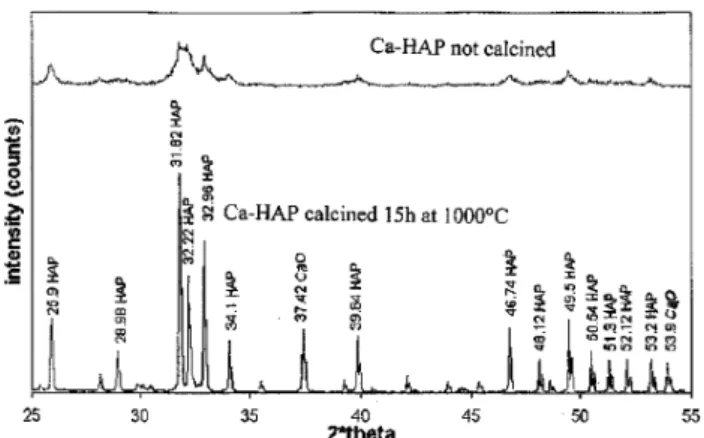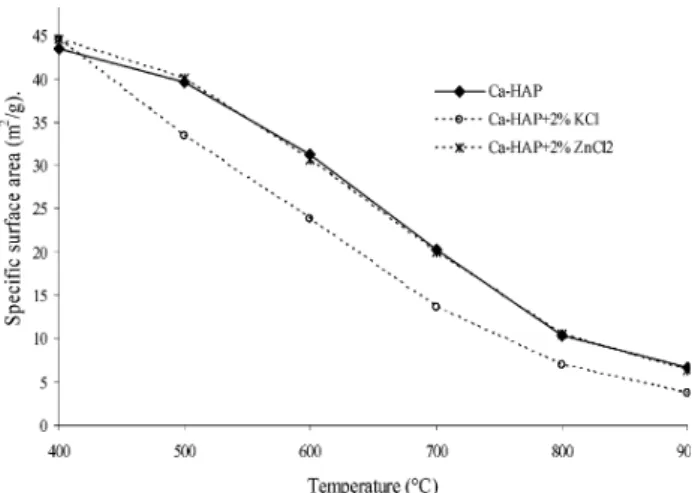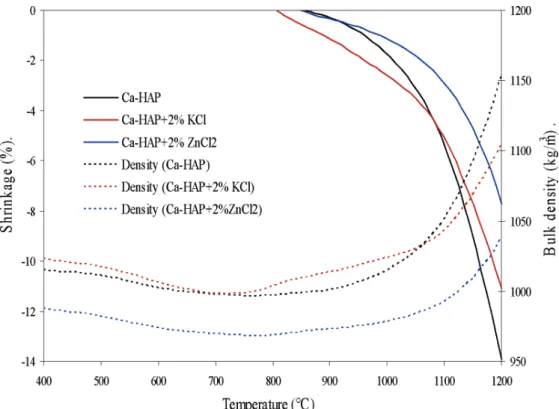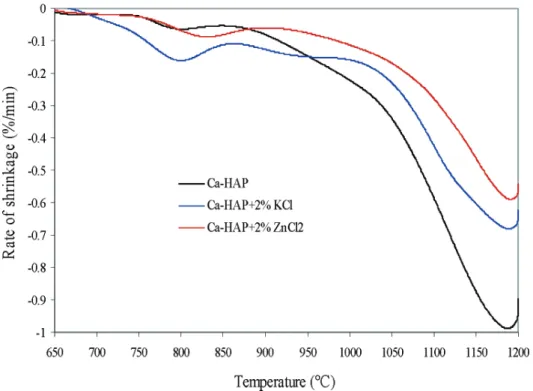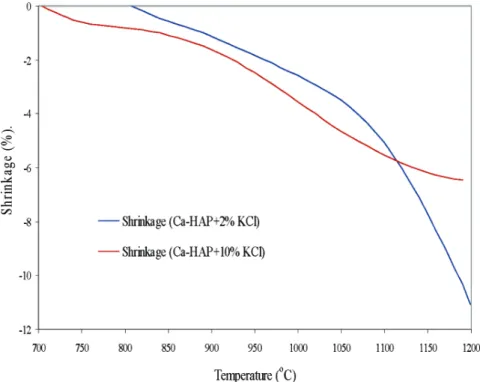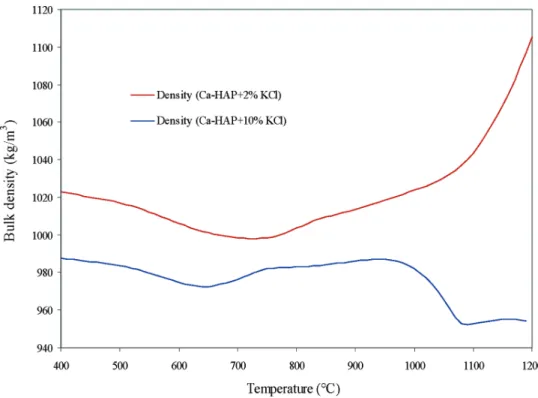HAL Id: hal-01634397
https://hal.archives-ouvertes.fr/hal-01634397
Submitted on 6 Nov 2018
HAL is a multi-disciplinary open access
archive for the deposit and dissemination of
sci-entific research documents, whether they are
pub-lished or not. The documents may come from
teaching and research institutions in France or
abroad, or from public or private research centers.
L’archive ouverte pluridisciplinaire HAL, est
destinée au dépôt et à la diffusion de documents
scientifiques de niveau recherche, publiés ou non,
émanant des établissements d’enseignement et de
recherche français ou étrangers, des laboratoires
publics ou privés.
Effect of metal chlorides on the sintering and
densification of hydroxyapatite adsorbent
Ange Nzihou, Benu Adhikari, R Pfeffer
To cite this version:
Ange Nzihou, Benu Adhikari, R Pfeffer. Effect of metal chlorides on the sintering and densification of
hydroxyapatite adsorbent. Industrial and engineering chemistry research, American Chemical Society,
2005, 44 (6), p.1787-1794. �10.1021/ie0306473�. �hal-01634397�
Effect of Metal Chlorides on the Sintering and Densification of
Hydroxyapatite Adsorbent
A. Nzihou,*,†B. Adhikari,‡and R. Pfeffer§
Ecole Des Mines d’Albi-Carmaux, Centre Energetique - Environnement, LGPSD, UMR CNRS 2392, Campus Jarlard, 81013 Albi Cedex 09, France, Environmental-Chemical Engineering, University of Queensland, St. Lucia, 4072 Brisbane, Australia, and New Jersey Center for Engineered Particulates, New Jersey Institute of Technology, Newark, New Jersey 07102
This work is part of a series of studies dealing with the evaluation of the effects of major elements of solid waste, especially metallic oxides, nitrates, sulfates, and chlorides, on the sintering and the densification of calcium hydroxyapatite (Ca-HAP) adsorbent. The effects of chloride salts of potassium (KCl) and zinc (ZnCl2) on sintering and densification of Ca-HAP were studied using surface area reduction and shrinkage measurements. The addition of KCl (2% w/w) activated the sintering process by bringing a swift reduction in surface area and lowering the densification temperature. However, a low final densification was achieved. Increasing the amount of this additive to 10% w/w further lowered the final densification and lowered the densification temperature of hydroxyapatite by 150 °C. On the other hand, the addition of 2 wt % of ZnCl2 deactivated the sintering process by slowing down the densification process and raising the densification temperature. However, the reduction of surface area was comparable to that of Ca-HAP. The densification rate contained two or more rate maxima indicating the additives (salts) bring multiple speeds in the densification process.
1. Introduction
This work is part of a series of studies dealing with the evaluation of the effects of major elements of solid waste, especially metallic oxides, nitrates, sulfates, and chlorides, on the sintering and the densification of calcium hydroxyapatite, Ca-HAP (or HAP) adsorbent. Ca-HAP, Ca10(PO4)6(OH)2, is a promising compound for
adsorption and immobilization of heavy metals from soils, incinerator fly ashes, and hazardous industrial wastes.1-8 The immobilization of heavy metals by
Ca-HAP increases significantly by calcination at tem-peratures ranging from 650 to 900 °C. Calcination leads to sintering and densification of Ca-HAP, which de-creases the leachability of the incorporated metal ions.8-10
The sintering phenomenon is influenced by the compo-sition of the solid waste considered.11-13
A number of papers describing sintering processes and mechanisms are available in the literature.11-28
Sintering is described as the bonding together of par-ticles at high temperatures. It can occur at temperatures below the melting point by solid-state atomic transport but in many instances involves the formation of a liquid phase. On a microstructural scale, the bonding occurs due to the growth of cohesive necks at particles contacts, even though the particles are at temperatures lower than their melting temperature.
Particles sinter by atomic motions that eliminate the high surface energy associated with the powder. The surface energy per unit volume depends on the inverse of the particle diameter. Typically, the surface energy
depends on the surface area. Thus, smaller particles with high specific surface areas have more energy and sinter faster. However, not all surface energy is avail-able for sintering. The sintering mechanism describes the path of atomic motion, which produces the mass flow. For metal powders, the mechanisms are usually diffusion processes over the surfaces, along the grain boundaries, or through the crystalline lattice. The stages of sintering follow a geometric progression. They relate to the driving force and kinetics and are used to mathematically describe the process.
The structural changes associated with neck growth during sintering depend on transport mechanisms, which are mainly diffusion processes. Diffusion is ther-mally activated, meaning that a specific energy is necessary for atomic movement. The mechanisms of sin-tering are due to volume diffusion and surface diffusion, viscous flow, and evaporation-condensation. These mechanisms are distinguished by the relationship of the radius of ‘‘neck” growth of two particles of the same size, as a function of time. These relationships have been discussed by numerous investigators and have been used to describe the sintering mechanism of different materials.23The rate of growth of the neck with time
depends on which sintering mechanism is prevalent. Motion depends on an atom attaining an energy equal to or above the activation energy to break free from its current site and move into a vacant site. The geometric progression associated with sintering can be divided into three stages. During the initial stage, bonds form at the particle contacts. As densification proceeds, new con-tacts form; hence, there are variations in the degree of sintering from point-to-point in the microstructure due to delayed contact formation. With prolonged sintering, the pore structure becomes smoothed, leading to the intermediate stage, which corresponds to the open, continuous pore structure that exists between densities of approximately 70 and 92% of the theoretical.16In the
* Corresponding author. Tel: +33 5 63 49 32 22. Fax: +33 5 63 49 30 99. E-mail: nzihou@enstimac.fr. A.N. is currently a visiting Associate Professor at the New Jersey Institute of Technology.
†Ecole Des Mines d’Albi-Carmaux. ‡University of Queensland.
intermediate stage, the sintering rate is continuously decreasing and is very sensitive to the pore-grain boundary morphology. Grain growth occurs in the later portion of sintering during which the pores become spherical and isolated. Elimination of isolated pores becomes difficult at that point. The final stage of sintering corresponds to closed, spherical pores that shrink slowly by vacancy diffusion to grain boundaries. Such densification is sensitive to the relative grain size and the attachment of pores to grain boundaries. Any atmosphere (gases) trapped in the pores will inhibit final densification.
These stages of sintering represent a changing driving force for mass flow at high temperature. In response to the driving force, the mechanisms of sintering represent the actual mass flow paths. The initial strain after compaction can lead to a plastic flow contribution to sintering, but generally diffusive processes are domi-nant. Possible diffusion paths include lattice, grain boundary, and surface regions. There is a characteristic distinction between surface and bulk processes. Bulk transport gives densification, while surface transport gives interparticle bonding without densification. It is typical to use computer simulations to quantify the sintering models.
Chemical additives that modify diffusion rates during sintering are often used. The additives can stabilize the desirable structure or, more typically, can form a liquid phase to increase the rate of sintering. In a recent paper,14 we discussed the effect of metal oxides and
metal nitrates on the sintering and densification of Ca-HAP. These results shows activated sintering for both the metal-oxides and metal-nitrates investigated. Here, we discuss the effects of chloride salts on the sintering and the densification of Ca-HAP.
2. Materials and Methods
Analytical-grade zinc chloride (ZnCl2) and potassium
chloride (KCl) were obtained from PROLABO and ChemPur (Germany), respectively. They were finely ground before use. Calcium hydroxyapatite (Ca-HAP) was prepared by mixing calcium nitrite [Ca(NO3)2] and
ammonium hydrogen phosphate [(NH4)2HPO4] both
obtained from NORSKHYDRO. The temperature was maintained at 25 °C, and the pH was adjusted to 7-8 with 10% ammonia solution according to the following reaction:
The details of the preparation and purification pro-cedure of Ca-HAP through the route of reaction 1 is given elsewhere.15The powder was finely ground using
a laboratory scale grinder (IKA Works, Inc.) to obtain fine particles with a narrow size distribution. Thermal stabilization of the powder was carried out by subjecting it to 400 °C for 2 h. The stabilized sample exhibited agglomeration, and the particle size was widely altered. Hence, the powder was ground again to obtain finer particles of mean size 5 microns. This stabilized Ca-HAP powder was used throughout the study.
The structure and the composition of the dried particles was identified and quantified by X-ray powder diffractometry (Siemens D5000). XRD measurements were carried out with Cu KR radiation generated at 40 kV and 40 mA, in the 3° < 2θ < 60° range at a scan
speed of 2 °C/min. The phases present were determined by comparing the patterns with JCPDS standards. The calcium and phosphorus content were determined using atomic absorption spectrometry (Varian spectrAA-400 plus).
The XRD reference of the hydroxyapatite was ob-tained according to the AFNOR standard29(calcination
during 15 h at 1000 °C). The calcination allows for the crystallization of the particles (as compared to the uncalcined particles) as shown in Figure 1 for Ca-HAP
.Approximately 2 wt % of Ca(OH)2was detected in this
Ca-HAP. The Ca/P ratio is of 1.7275, which becomes a mixture of lime (Ca(OH)2) and hydroxyapatite at high
temperature. Since the Ca/P ratio of stoichiometric hydroxyapatite is 1.6667, the Ca-HAP used for our study is clearly an hydroxyapatite with a calcium excess.
The specific surface area of the samples was deter-mined using nitrogen adsorption with the BET method (MICROMETRICS Gemini Vacprep 061). The solid density of the Ca-HAP was determined by helium pycnometry (MICROMETRICS, Accupyc 1330). The specific surface area and the solid density of the Ca-HAP powder were 43.48 m2/g and 2987 kg/m3,
respectively. The mass loss history of the samples was determined in dynamic mode using a Themogravimetric Analyzer (TGA-DTA, NETZSCH-STA 409) at a scanning rate of 10 °C from room temperature to 1200 °C.
The shrinkage tests of the samples were carried out by a Thermomechanical Analyzer (TMA, SETARAM Setsys 16/20) with a 5 g constant load. The shrinkage, due to rise in temperature, is defined as ∆H/H0, where
H0is the initial height of the sample and ∆H ) H0
-H(t). H(t) is the height of the sample as a function of
time. The relative density of the sintered specimen is expressed as Fb/Fs, where Fband Fsare the bulk and solid
density, respectively. The thermomechanical analyses (dilatometry) were carried out in dynamic mode with a scanning rate of 10 °C/min from room temperature up to 1200 °C.
The evolution of the bulk density of the specimen as a function of temperature can be determined from the measured shrinkage history. The bulk density is an important parameter and is related to the voidage of the specimen. This quantity is also important for following the relative density (Fb/Fs) of the sample. The
bulk density (Fb) can be determined from the equation
given below15 10Ca(NO3)2+ 6(NH4)2HPO4+ 8NH4OH f
Ca10(PO4)6(OH)2+ 20NH4NO3+ 6H2O (1)
Figure 1. XRD pattern of not calcined and calcined Ca-HAP during 15 h at 1000 °C.
Fb) mo[100 - weight losss (%)] πr2H
o[100 - shrinkage (%)]
where moand Hoare the initial mass (kg) and height
(m) of the sample, and r is the inner radius (m) of the crucible in the dilatometer (TMA). Equation 2 was derived assuming that the variation in the sample dimension is isotropic and unidirectional and that the weight of the mass remains constant at the temperature range of interest.
Calcination experiments were carried out in a furnace (AUBRY Co., France). A heating rate of 10 °C/min was imposed from room temperature to the designated isothermal temperatures; isothermal conditions were maintained for 2-300 min. The samples were placed in an alumina crucible and subjected to the above calcination regime under flowing air and cooled to room temperature at a rate of 10 °C/min. The heating (scan-ning) rate of 10 °C/min was imposed for TGA and TMA experiments, as well as for the calcination process in order to facilitate a comparison. The surface character-istics of the sintered agglomerate as well as the un-sintered particles/aggregates were studied using an environmental scanning electron microscopy (XL 30 ESEM-FEG, Phillips). The ESEM micrographs, when combined with the mass loss (TGA) and the shrinkage (TMA), provide excellent insight into the densification process.
3. Results and Discussion
3.1. Effect of Chloride Salts of K and Zn on Sintering and Densification of Ca-HAP. Figure 2
presents the variation of the specific surface area of Ca-HAP and its mixtures with 2% (w/w) of KCl and ZnCl2as a function of temperature. The evolution of the
shrinkage rate and the bulk density of these mixtures, as a function of temperature, are presented in Figure 3 together with the evolution of the shrinkage rate and bulk density of pure Ca-HAP.
3.1.1. Effect of Potassium Chloride KCl. As shown
in Figure 2 the specific surface area of the 2% mix-ture of KCl with Ca-HAP is much lower than that of Ca-HAP at all temperatures. As the mean particle size (5microns) of the KCl additive was of the same order as that of Ca-HAP, the much lower specific surface area (30% difference) below 800 °C means that this additive accelerates the process of surface area reduction of C-HAP.
Figure 3 shows that the densification of the mixture of Ca-HAP and KCl commences at about 800 °C, which
is at about 50 °C lower than that of pure Ca-HAP. The rate of sintering of this mixture is faster when compared to Ca-HAP up to 1080 °C and then falls short and attains a lower final shrinkage. These observations imply that it is difficult to establish a direct relationship between the surface area reduction and the densification process. The results of the mixture of KCl with Ca-HAP show that surface area can reduce significantly even if the densification is negligible. The bulk density data (Figure 3) of these samples are simply another inter-pretation of the densification process.
The delay in densification can be explained by the slow evaporation of H2O from the decomposition of
Ca(OH)2to CaO that is present in the Ca-HAP.15Since
melting of KCl at 771 °C can cause the particles to bind together, the evaporation of H2O generates a volume
expansion (puffing action), which slows and delays the densification.30The result of that process could explain
the low shrinkage observed even though the ESEM micrographs of the Ca-HAP mixture with 2% KCl (see Figure 4a) show surface densification at 1200 °C. A similar delay of the densification process has already been observed during the natural sintering (without load applied on the sample) of Ca-HAP containing excess calcium in the form of Ca(OH)2.10,14,15
Figure 5 compares the rate of shrinkage of Ca-HAP and 2% mixtures of KCl and ZnCl2with Ca-HAP. This
figure agrees well with Figure 2 and shows that the rate of densification of Ca-HAP with KCl is faster than that of Ca-HAP alone up to 950-980 °C, above which temperature the rate declines very sharply. The maxi-mum densification of the mixture is achieved below 1200 °C, indicating that there is no possibility of further densification or sintering above this temperature unless the chemical structure changes due to a partial dehy-droxylation of Ca-HAP and the formation of tetracal-cium phosphate monoxide (Ca4O(PO4)2) and
R-trical-cium phosphate [Ca3(PO4)2]. This corroborates well with
the results of Figures 2 and 3 that the mixture of Ca-HAP with 2% KCl undergoes a higher degree of shrinkage and surface area reduction compared to that of pure Ca-HAP.
The phenomenon that we observed with the 2% KCl mixture is referred to in the literature as “acti-vated sintering”. Acti“acti-vated sintering16is a process which
lowers the activation energy, allowing for a lower sintering temperature and shorter sintering time by the addition of a layer of a second component (guests) to the particles undergoing sintering (hosts). In general, the activator must be either a metal or a compound, which forms a lower melting temperature phase than the metallic host particles during the sintering. The activator must have a large solubility for the base metal, while the base metal should have a low solubility for the activator. For example, KCl melts at 771 °C, which corresponds to a temperature close to the sintering temperature zone of Ca-HAP. The activator should also remain segregated at the interparticle interfaces during sintering. This segregated layer provides a high diffu-sivity path for rapid sintering. The lower melting point ensures a lower activation energy for diffusion, while the low solubility ensures that the activator is not dissolved into the base metal.
In two-phase systems involving mixed powders, it is possible to form a low melting phase. In such a system, the liquid provides for rapid transport and therefore rapid sintering. That is possible if the wetting liquid
Figure 2. Specific surface area of Ca-HAP and mixtures of 2% KCl and ZnCl2as a function of temperature.
forms a film around the solid phase. Finally the diffusive transport for the dissolved solid atoms should be high enough to ensure rapid sintering. The liquid film provides a surface tension force to aid in densification resulting in a densification rate that is much higher than in solid-state sintering.
Activated sintering has also been used to describe the formation of composites whereby a low concentration of one material is added to another material to promote grain boundary segregation so as to increase diffusion rates.31 The increase in diffusion gives rise to faster
rates of sintering, hence a lowering of the sintering temperature of the material.32,33
Effect of Increasing the Concentration of KCl.
The effect of changing the concentration of KCl on the surface area reduction of Ca-HAP is presented in Figure 6. This figure shows that the specific surface areas of a 10% mixture of KCl with Ca-HAP, at a given temper-ature, are always lower than those of the corresponding 2% mixture. This implies that an increase in the concentration of KCl up to 10% helps to accelerate the reduction in the surface area reduction of Ca-HAP, indicating that increasing the amount of activator could improve activated sintering
The evolution of the shrinkage of 2% and 10% mix-tures of KCl, as a function of temperature, are compared
Figure 3. Variation of shrinkage (%) and bulk density (m2/g) of Ca-HAP and the mixtures of Ca-HAP with 2% KCl and 2% ZnCl2as a
function of temperature.
Figure 4. Environmental scanning electron micrographs of (a) Ca-HAP + 2% KCl and (b) Ca-HAP + 2% ZnCl2sintered at different
in Figure 7. This figure shows that the densification of Ca-HAP + 10% KCl commences at about 700 °C compared to 800 °C for Ca-HAP + 2% KCl. This means that an increase in the amount of KCl can significantly enhance activated sintering by lowering the sintering temperature at which densification begins. The final shrinkage of Ca-HAP + 10% KCl is 6.5% compared to 11.1% for Ca-HAP + 2% KCl. Figure 8 shows that the rate of shrinkage of Ca-HAP + 10% KCl is much lower as compared to that of Ca-HAP + 2% KCl above 1043 °C. There are two densification (shrinkage) maximums at 680 and 1000 °C; the former may be due to the proximity of the melting point of KCl (771 °C).
The evolution of bulk density for 2% and 10% mix-tures of KCl with Ca-HAP, as a function of temperature, is presented in Figure 9. The salient feature of this figure is that the bulk densities of the specimens with 10% additive decrease, rather than increase, as the
sintering progressed. This is due to the melting of KCl that forms more bonds between particles at 10% KCl than at 2% KCl. Shrinkage is retarded due to the increased volume expansion by swelling favorable for the evaporation of water as explained previously. This also indicates that as the percent of KCl in Ca-HAP is increased, a more porous powder is produced.
3.1.2. Effect of Zinc Chloride ZnCl2. Figure 2
shows that the reduction in specific surface area of Ca-HAP + 2% ZnCl2 is very close to that of Ca-HAP
throughout the temperature range investigated. The average difference is 4.15%, which is within the mea-surement error of the equipment. This means that the addition of ZnCl2 does not affect the surface area
reduction of Ca-HAP at this concentration even though the melting temperature of ZnCl2is only 293 °C. Figure
3 shows that the evolution of the shrinkage of Ca-HAP + 2% ZnCl2is much slower compared to that of pure
Ca-HAP and that the final shrinkage was much less (7.7%). Hence, it can be concluded that the addition of ZnCl2 retards the densification of Ca-HAP. This is
referred to in the literature as ‘‘deactivated sintering”, whereby the minimum sintering temperature of the host material (Ca-HAP) is increased by the addition of a layer of a second (guest) component (ZnCl2).
Deactivated sintering can be defined as a process whereby the surface of the host particles is covered with a layer of another material (guest) to delay and reduce the sintering of the host material, hence causing an increase in the minimum sintering temperature. Since the melting temperature of ZnCl2is 293 °C, the Ca-HAP
may be covered by a discrete layer of melting ZnCl2. The
deactivated sintering observed is discussed below. The delay in sintering might be caused by an increase in the activation energy of the system, which gives rise to slower rates of diffusion. The question arises as to what is the importance and/or application of increasing the sintering temperature of particulate materials. Recently, a number of papers have appeared in the
Figure 5. Shrinkage rate (%/min) of Ca-HAP and mixtures of Ca-HAP with 2% KCl and 2% ZnCl2as a function of temperature.
Figure 6. Variation of the specific surface area (m2/g) of Ca-HAP,
a 2% and 10% mixture of KCl with Ca-HAP as a function of temperature (time ) 2 h).
literature34-37describing the phenomenon of deactivated
sintering which was observed after applying a discrete coating of metallic oxide powders onto the surface of a variety of host powders to change their surface proper-ties. This caused a reduction in the sintering rate and an increase in the minimum sintering temperature of the host particulate materials.
Figure 5 further shows that the rate of densification of a Ca-HAP-ZnCl2mixture is always smaller than that
of Ca-HAP and that it retards the densification process. This result is confirmed by the ESEM micrographs in
Figure 4b showing the mixture of ZnCl2with Ca-HAP
sintered at different temperatures. It can be seen that, the surface of the agglomerates of the mixture of Ca-HAP + 2% ZnCl2 at 1200 °C is porous and not
completely coalesced. This indicates that the addition of ZnCl2retards the densification process and fails to
bring a reduction in surface area.
The explanation for the low densification and deac-tivated sintering observed for the 2% ZnCl2 additive
could be the following. For Ca-HAP containing 2 wt % of Ca(OH)2, the shrinkage begins at 600 °C; this
Figure 7. Variation of the shrinkage (%) for a 2% and 10% mixture of KCl with Ca-HAP as a function of temperature.
temperature corresponds to the decomposition of lime Ca(OH)2to CaO. The reduction in length observed in
the porous structure of Figure 4b could be explained by the effect of the generation of the porosity by evapora-tion of water.10,14,15This phenomenon may increased by
the evaporation of ZnCl2at 732 °C through the pores.
So, under the load of the thermomechanical analyzer this porous medium shrinks and leads to the reduction in length observed.
An increase in the concentration of ZnCl2to 10% could
possibly further improve the deactivated sintering observed for the mixture Ca-HAP + 2% ZnCl2. But, the
results obtained with a mixture of Ca-HAP with 10% ZnCl2 were not relevant because of the presence of a
significant amount of molten ZnCl2 that prevented
accurate measurement of the shrinkage using the dilatometer.
4. Conclusions
The effect of chloride salts of potassium and zinc on the sintering and densification of calcium hydroxyapa-tite (Ca-HAP) was studied by monitoring the reduction in specific surface area and shrinkage. The effect of concentration of these additives was also investigated using 2% and 10% (KCl only) of these additives solid mixtures with Ca-HAP. The addition of 2% w/w of KCl in Ca-HAP produced a substantial reduction in surface area and a further increase to 10% produced an even greater reduction in the specific surface area. The 2% w/w KCl activates the sintering by lowering the densi-fication temperature by 50 °C; the 10% w/w lowered the densification temperature by 150 °C. However, the final shrinkage of the mixture containing 10% KCl was much lower than the 2% KCl mixture with Ca-HAP. The addition of 2% of ZnCl2 in Ca-HAP did not show a
reduction in specific surface area of the Ca-HAP and served to deactivate the sintering by retarding the densification process and lowering the rate of shrinkage as well as the final shrinkage. Hence, there does not
appear to be any correlation between surface area reduction and the volume shrinkage. The rate of shrink-age of the mixture had two or more peaks indicating that the additives bring about multiple speeds in the densification process.
Literature Cited
(1) Mavropoulos, E.; Rossi, A. M.; Costa, A. M.; Perez, C. A.; Moreira, J. C.; Saldanha, M. Studies on the mechanisms of lead immobilization by hydroxyapaties. Environ. Sci. Technol. 2002,
36, 1625.
(2) Ma, Q. Y.; Traina, S. J.; Logan, T. J.; Ryan, J. A. In situ lead immobilization by apatite. Environ. Sci. Technol. 1993, 27, 1803.
(3) Boisson, J.; Ruttens, A.; Mench, M.; Vangronsveld, J. Evaluation of hydroxyapatite as a metal immobilizing soil additive for the remediation of polluted soils. I. Influence of hydroxyapatite on metal exchangeability in soil, plant growth and plant metal accumulation. Environ Pollut. 1999, 104, 225.
(4) Laperche, V.; Traina, S. J.; Gaddam, P.; Logan, T. J. Chemical and minerological characterizations of Pb in a contami-nated soil: Reactions with synthetic apatite. Environ. Sci. Technol. 1996, 30, 3321.
(5) Nzihou, A.; Sharrock, P. Calcium phosphate stabilization of fly ash with chloride extraction. Waste Management. 2002, 22, 235.
(6) Iretskaya, S.; Nzihou, A.; Zahraoui, C.; Sharrock, P. Metal leaching from MSW fly ash before and after chemical and thermal treatments. Environ. Prog. 1999, 18, 144.
(7) Da Rocha, N. C. C.; De Campos, R. C.; Rossi, A.; Moreira, E. L.; Barbosa, A. D. F.; Moure, G. T. Cadmium uptake by hydroxyapatite synthesized in different conditions and submitted to thermal treatment. Environ. Sci. Technol. 2002, 36, 1630.
(8) Dong, Z.; White, T. J.; Wei, B.; Laursen, K. Model apatite system for the stabilization of toxic metals: I, Calcium lead vanadate. J. Am. Ceram. Soc. 2002, 85(10), 2515
(9) Bailliez, S. Adsorption du plomb sur des hydroxyapatites et frittage thermique: Processus cine´tiques et transfert thermique. Ph.D. Thesis, INSA de Lyon, France, 2003.
(10) Nzihou, A.; Bailliez, S. Mechanisms of sintering of macroporous hydroxyapatite adsorbents. High. Temp. Mater. Proc. 2002, 21, 281.
(11) German, R. M.; Munir, Z. A. Surface area reduction during isothermal sintering. J. Am. Ceram. Soc. 1976, 59, 379. Figure 9. Evolution of bulk density (kg/m3) of 2% and 10% mixtures of KCl with Ca-HAP as a function of experimental temperature.
(12) Itatani, K.; Takahashi, M.; Howell, F. S.; Aizawa, M. Effect of metal-oxide addition on the sintering of β-calcium orthophos-phate. J. Mater. Sci.: Mater. Med. 2002, 13, 707.
(13) Raynaud, S.; Champion, E.; Bernache-Assolant, D. Calcium phosphate apatites with variable Ca/P atomic ratio II. Calcination and Sintering. Biomaterials 2002, 23, 1073.
(14) Nzihou, A.; Adhicari, B. Effect of oxides and nitrates of lead on the sintering and densification of hydroxyapatites adsor-bents. Ind. Eng. Chem. Res. 2004, 43, 13, 3325.
(15) Bailliez, S.; Nzihou, A. The kinetics of surface area reduction during isothermal sintering of hydroxyapatite adsorbent.
Chem Eng J. 2004, 98, 141.
(16) German, R. M. Powder Metallurgy Science, 2nd ed.; Metal Powder Industries Federation: Princeton, NJ, 1994.
(17) German, R. M.; Munir, Z. A. Surface area reduction during isothermal sintering. J. Am. Ceram. Soc. 1976, 59, 379.
(18) German, R. M.; Munir, Z. A. Sintering and catalysis. In
Materials Sciences Research; Kuczynski, G. C., Ed.; Plenum
Press: New York, 1975; Vol. 10, pp 249-257. (19) Reference 18, pp 259-268.
(20) German, R. M.; Munir, Z. A. Identification of the initial stage sintering mechanism using aligned wires. J. Mater. Sci. 1976, 11, 71.
(21) Kuczynski, G. C. Self-diffusion in sintering of metallic particles. Trans. AIME 1949, 185, 169.
(22) Kuczynski, G. C. The mechanism of densification during sintering of metallic particles. Acta Metall. 1956, 4, 58.
(23) Kuczynski, G. C. Self-diffusion in sintering of metallic particles. Metals Trans. 1949, 169.
(24) Coble, R. I. Initial Sintering of Alumina and Hematite. J.
Am. Ceram. Soc. 1958, 41, 55.
(25) Coble, R. I. Sintering Crystalline Solids I: Intermediate and Final. State Diffusion Models. J. Appl. Phys. 1961, 32, 787. (26) German, R. M. Surface area reduction kinetics during intermediate stage sintering. J. Am. Ceram. Soc. 1978, 61, 272-274.
(27) Ranade, P. V.; Harrison, D. P. The grain model applied to porous solids with varying structural properties. Chem. Eng. Sci. 1979, 34, 427.
(28) Nicholson, D. Variation of surface area during the thermal decomposition of solids. Trans. Faraday Soc. 1965, 61, 990.
(29) Standard AFNOR NF S 94-066. 1998.
(30) Melin, G.; Chartier, T.; Bonnet, J. P. Volume expansion during reaction sintering of γ-Bi12SiO20. J. Eur. Ceram. Soc. 2000,
20, 45.
(31) Bonis, L. J.; Hausner, H. H. Fundamental Phenomena in
the Materials Science; Plenum: New York, 1964; Vol. 1.
(32) Johnson, J. L.; German, R. M. Theoretical Modeling of Densification During Activated Solid-State Sintering. Metall.
Mater. Trans. A 1996, 27A, 441.
(33) Luo, J.; Wang, H.; Chaing, Y.-M. Origin of Solid-State Activated Sintering in Bi O -Doped ZnO. J. Am. Ceram. Soc. 1999, 82, 23, 916.
(34) Alonso, M.; Satoh, M.; Miyanami, K. Powder Coating in a Rotary Mixer with Rocking Motion. Powder Technol. 1988, 56, 135.
(35) Alonso, M.; Satoh, M.; Miyanami, K. Mechanism of Com-bined Coating Mechanofusion Processing of Powders. Powder
Technol. 1989a, 59, 45.
(36) Ramlakhan, M. M.; Dave, R. N. Pfeffer, R. Promotion of deactivated sintering by dry-particles Coating. AIChE J. 2003, 49 (3), 604.
(37) Dukhin, S. S.; Yang, J.; Dave, R. N.; Pfeffer, R. Deactivated sintering by particle coating: the significance of static and dynamic surface phenomena. Colloids and Surfaces A: Physiochem. Eng.
